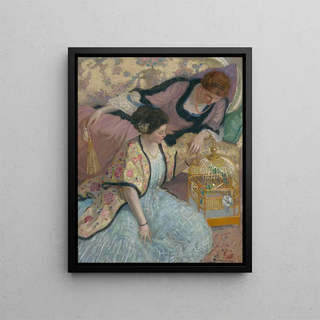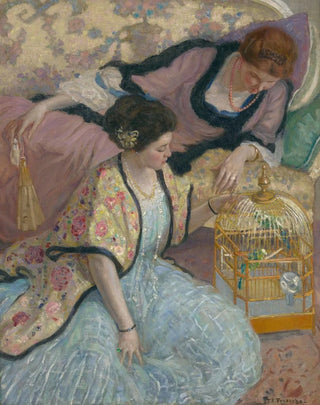Painting Les Perroquets - Frederick Carl Frieseke | Art print Source: Tableau Les Perroquets - Frederick Carl Frieseke | Reproduction


View from behind

Frame (optional)
Les Perroquets - Frederick Carl Frieseke – Captivating Introduction
In the vibrant universe of art, some works transcend mere creation to become windows into emotions, atmospheres, and stories. "Les Perroquets" by Frederick Carl Frieseke is one of those pieces that captivate the mind and awaken the senses. This canvas, where nature and humanity intertwine harmoniously, invites the viewer to immerse themselves in a world where beauty is omnipresent. As you contemplate this artwork, you cannot help but feel a deep connection with the vivid colors and delicate light that seem to dance across the surface of the canvas. Frieseke manages to evoke a sense of serenity and joy, making this piece not only a visual delight but also a true sensory experience.
Style and uniqueness of the artwork
Frieseke's style, often associated with the Impressionist movement, is distinguished by its bold use of colors and mastery of light. In "Les Perroquets," bright hues and delicate shades blend to create an almost fairy-tale atmosphere. The parrots, symbols of exotic nature, are depicted with such vivacity that they seem ready to take flight from the canvas. The composition is carefully thought out, with each element arranged to guide the viewer's gaze across the painting. The artist skillfully plays with shadows and lights, creating a depth that gives the work an almost three-dimensional quality. This ability to capture light and transform it into a visual melody is what makes "Les Perroquets" so unique and memorable.
The artist and his influence
Frederick Carl Frieseke, an emblematic figure of early 20th-century American art, established himself as a master of plein air painting. His artistic journey, marked by French Impressionist influences, led him to develop a distinctive style that is uniquely his own. Settling in Giverny, he was able to mingle with artists such as Claude Monet, which profoundly enriched his artistic vision. The influence of nature and the garden, omnipresent in his work, reflects his desire to capture the very essence of the

Matte finish

View from behind

Frame (optional)
Les Perroquets - Frederick Carl Frieseke – Captivating Introduction
In the vibrant universe of art, some works transcend mere creation to become windows into emotions, atmospheres, and stories. "Les Perroquets" by Frederick Carl Frieseke is one of those pieces that captivate the mind and awaken the senses. This canvas, where nature and humanity intertwine harmoniously, invites the viewer to immerse themselves in a world where beauty is omnipresent. As you contemplate this artwork, you cannot help but feel a deep connection with the vivid colors and delicate light that seem to dance across the surface of the canvas. Frieseke manages to evoke a sense of serenity and joy, making this piece not only a visual delight but also a true sensory experience.
Style and uniqueness of the artwork
Frieseke's style, often associated with the Impressionist movement, is distinguished by its bold use of colors and mastery of light. In "Les Perroquets," bright hues and delicate shades blend to create an almost fairy-tale atmosphere. The parrots, symbols of exotic nature, are depicted with such vivacity that they seem ready to take flight from the canvas. The composition is carefully thought out, with each element arranged to guide the viewer's gaze across the painting. The artist skillfully plays with shadows and lights, creating a depth that gives the work an almost three-dimensional quality. This ability to capture light and transform it into a visual melody is what makes "Les Perroquets" so unique and memorable.
The artist and his influence
Frederick Carl Frieseke, an emblematic figure of early 20th-century American art, established himself as a master of plein air painting. His artistic journey, marked by French Impressionist influences, led him to develop a distinctive style that is uniquely his own. Settling in Giverny, he was able to mingle with artists such as Claude Monet, which profoundly enriched his artistic vision. The influence of nature and the garden, omnipresent in his work, reflects his desire to capture the very essence of the
12,34 €






